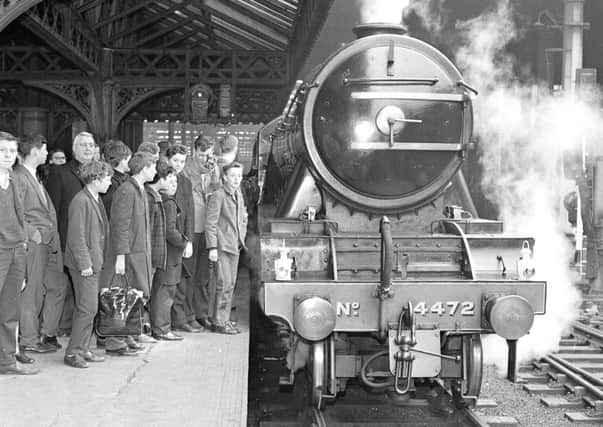The Edinburgh to Glasgow line, on track since 1842


The Edinburgh to Glasgow mainline via Falkirk High is a pillar of the Scottish economy, used by thousands of commuters each day.
The building of a railway between the two cities was authorised by an Act of Parliament in 1838 following several years of public discussion. The success of the Liverpool and Manchester Railway, opened in 1830, led to demand across Britain for new inter-city routes.
Advertisement
Hide AdAdvertisement
Hide AdConstruction work on the 46-mile line took almost four years. It was no easy task. To ensure a level route, numerous cuttings were dug, four viaducts were built and three tunnels were driven through hills and solid rock.
Members of the public were invited to walk through the Queen Street tunnel on New Year’s Day 1842 to satisfy growing interest in the project. The line opened to regular services on 21 February that year, following a ceremonial opening two days earlier.
The railway put an end to the slow and cumbersome stagecoaches that had linked Glasgow and Edinburgh for more than a century, and would eventually drive business away from the canal network as well.
The project’s engineers had wanted to build a bridge over the Forth and Clyde canal – but the canal’s owners refused. A tunnel under the waterway had to be constructed instead.
Advertisement
Hide AdAdvertisement
Hide AdThe Scotsman reported in February 1842 that “it rarely happens that a railway can be brought into the centre of a great city”, as it announced the opening of Queen Street station in Glasgow. But the original Edinburgh terminus at Haymarket was greeted with rather less enthusiasm. Even then, the newspaper hoped the new railway would be promptly extended into the centre of town. An extension to North Bridge was duly completed in 1846, and work on building the present Waverley station began in 1868.
The line was popular with passengers from the beginning. Initially, four services travelled in each direction from Monday to Saturday. Controversially, two services also ran on Sundays – provoking strong opposition from Sabbatarians. The number of trains throughout the week quickly increased.
Passengers could choose to alight at many more intermediate stations than today – with stops at Gogar, Ratho, Winchburgh, Linlithgow, Polmont, Falkirk, Castlecary, Croy, Kirkintilloch (later Lenzie) and Bishopbriggs. The Edinburgh & Glasgow Railway Company which built the line was absorbed by the North British Railway (NBR) in 1865. The NBR would in turn be absorbed by the London & North Eastern Railway in 1923.
There have been several high-profile train crashes on the route over the years. The most recent occurred on 30 July, 1984, when a rush hour commuter service out of Waverley struck a cow that had wandered on to the tracks near Polmont from a nearby field. The collision caused all six carriages to derail, killing 13 people and injuring 61 others.
Advertisement
Hide AdAdvertisement
Hide AdThe worst accident, in terms of loss of life, took place on 10 December, 1937, at Castlecary. During a snowstorm, the 5.30pm Waverley to Queen Street express collided with a late running local train from Dundee to Glasgow. The locomotive hit the rear of the standing local service at the now-closed Castlecary station at an estimated 70mph. Four carriages were completely destroyed by the collision, killing 35 passengers and injuring 179 more. An eight-year-old girl was listed as missing.
The £742m Edinburgh Glasgow Improvement Programme (EGIP) is the biggest project on the route since it was built 174 years ago. It will eventually see all-electric trains operating on the line, with faster journey times and more seats for passengers.
A new passenger hall at Haymarket station opened in 2014, while Queen Street will be comprehensively rebuilt by 2019.
Essential engineering works on the line, such as the temporary closure of the Winchburgh tunnel last year, have caused major disruption for passengers. The Queen Street tunnel closed to traffic on 20 March and will not reopen until 8 August. During that time, trains to Waverley will travel via Queen Street low level, but passengers from Glasgow are advised to use services to Edinburgh via Bathgate instead.